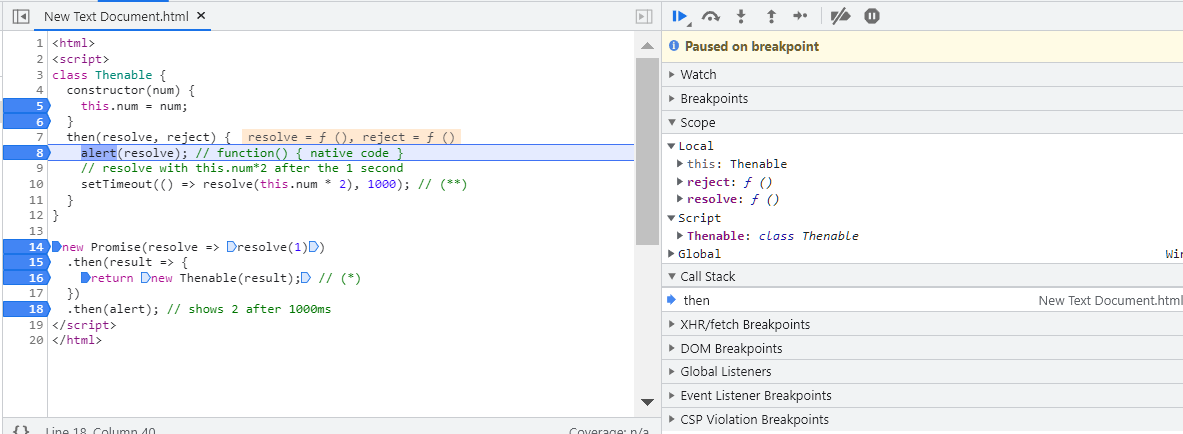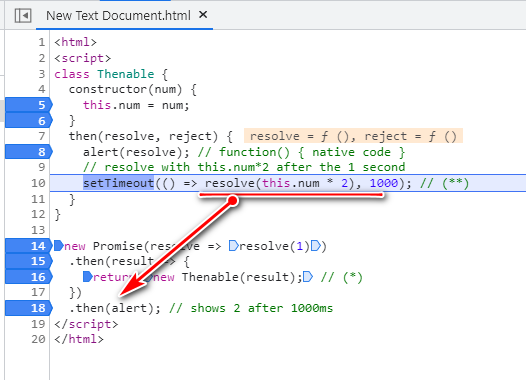JavaScript 在 Promise.then 方法里返回新的 Promise
看一个实际的例子:
loadScript("/article/promise-chaining/one.js")
.then(function(script) {
return loadScript("/article/promise-chaining/two.js");
})
.then(function(script) {
return loadScript("/article/promise-chaining/three.js");
})
.then(function(script) {
// use functions declared in scripts
// to show that they indeed loaded
one();
two();
three();
});
按照先后顺序,依次加载 one.js, two.js, three.js
当然也可以使用箭头函数的语法:
loadScript("/article/promise-chaining/one.js")
.then(script => loadScript("/article/promise-chaining/two.js"))
.then(script => loadScript("/article/promise-chaining/three.js"))
.then(script => {
// scripts are loaded, we can use functions declared there
one();
two();
three();
});
这里每个 loadScript 调用,都会返回一个 promise,这个新的 promise,在其被 resolve 时,会触发下一个 .then 的执行。
于是它开始加载下一个脚本。 所以脚本一个接一个地加载。
我们可以向链中添加更多异步操作。 请注意,代码仍然是 flat 的——它向下增长,而不是向右增长。
这种方式没有 pyramid of doom 的迹象。
虽然我们可以在 then 后面直接调用 loadScript:
loadScript("/article/promise-chaining/one.js").then(script1 => {
loadScript("/article/promise-chaining/two.js").then(script2 => {
loadScript("/article/promise-chaining/three.js").then(script3 => {
// this function has access to variables script1, script2 and script3
one();
two();
three();
});
});
});
此代码的作用相同:依次加载 3 个脚本。 但它 向右增长, 所以本质上仍然有回调地狱的问题。
Thenables 对象
准确地说,then 处理程序可能返回的不完全是一个 Promise,而是一个所谓的 thenable 对象——一个具有 .then 方法的任意 JavaScript 对象。 它将被视为与 Promise 相同的方式被处理。
这个想法是第 3 方库可以实现自己的 promise-compatible 对象。 它们可以有一组扩展的方法,但也可以与原生 Promise 兼容,因为它们实现了 .then。
看一个例子:
class Thenable {
constructor(num) {
this.num = num;
}
then(resolve, reject) {
alert(resolve); // function() { native code }
// resolve with this.num*2 after the 1 second
setTimeout(() => resolve(this.num * 2), 1000); // (**)
}
}
new Promise(resolve => resolve(1))
.then(result => {
return new Thenable(result); // (*)
})
.then(alert); // shows 2 after 1000ms
单步调试:
- 14 行 new Promise 内部的 executor 得到执行,立即 resolve,抛出 result 1

- 这会导致代码第 15 行 then 里的函数立即被调用,输入参数为 1,构造一个新的 Thenable 对象。

JavaScript 在第 16 行中检查 .then 处理程序返回的对象:如果它有一个名为 then 的可调用方法,那么它调用该 then 方法,并提供本地函数 resolve、reject 作为参数(类似于执行程序)并等待其中一个被调用。 在上面的示例中,resolve(2) 在 1 秒 (**) 后被调用。然后将结果进一步向下传递。
因此,下图第 16 行代码单步调试之后,会自动进入代码第 8 行。

- 打印出 resolve 原生函数的 native code 字符串。

- 代码第 10 行的 resolve,会触发第 18 行第二个 then 方法:

- 点赞
- 收藏
- 关注作者


评论(0)